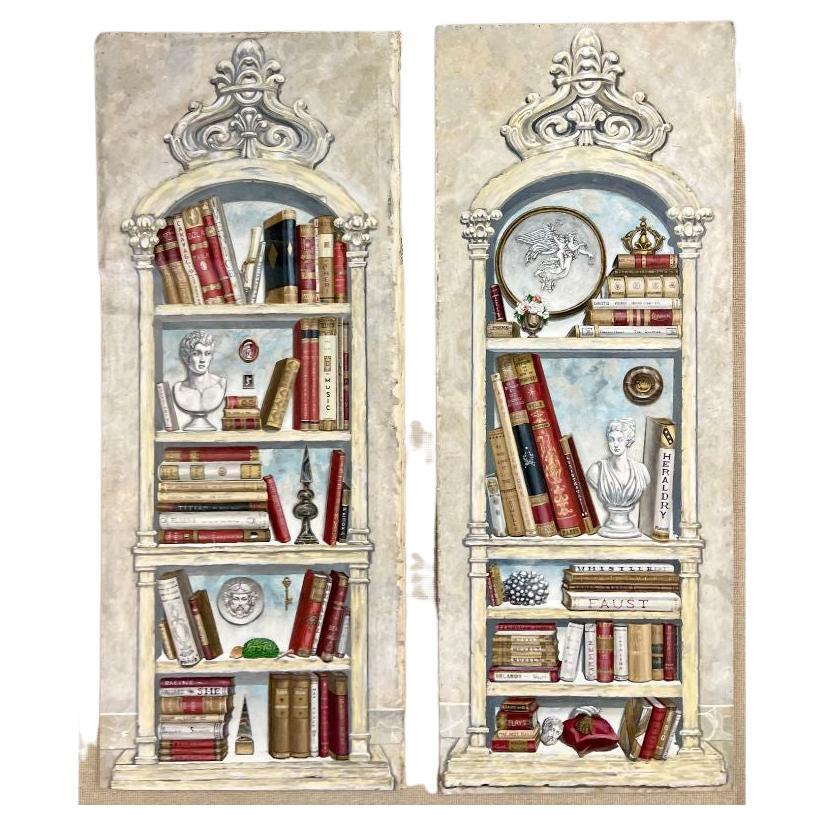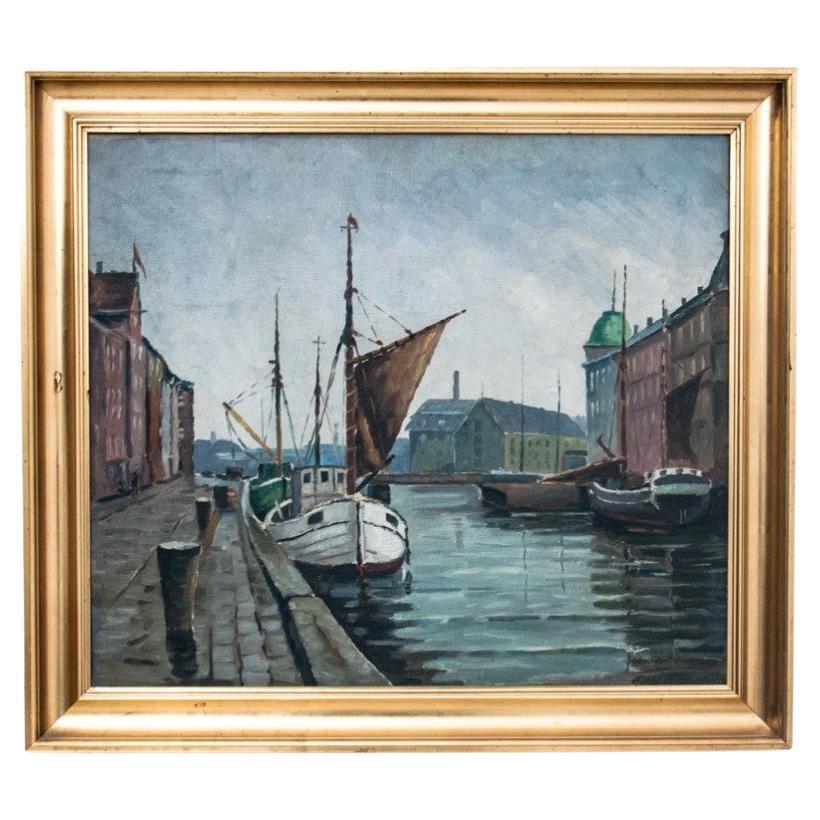Items Similar to XX Century Wall Decoration in Style of Pompeii
Video Loading
Want more images or videos?
Request additional images or videos from the seller
1 of 11
XX Century Wall Decoration in Style of Pompeii
About the Item
The ancient city of Pompeii was founded sometime around the 7th or 6th century BCE by the Oscans, an Italic tribe that inhabited the region of Campania in what is now southern Italy. Pompeii was strategically situated near the Bay of Naples, close to fertile agricultural lands and important trade routes, which contributed to its growth and prosperity over the centuries.
The city's early history is somewhat obscure, but archaeological evidence suggests that it was initially a small settlement with modest dwellings and agricultural activities. Over time, Pompeii developed into a thriving urban center, influenced by various cultures, including the Greeks and Etruscans.
Pompeii's strategic location and economic significance led to its eventual domination by the ancient Romans. By the 4th century BCE, Pompeii had become a Roman colony, and its development accelerated under Roman rule. The city benefited from Roman infrastructure projects, such as the construction of roads, aqueducts, and public buildings, which transformed it into a bustling commercial hub and popular resort destination.
However, Pompeii's prosperity was abruptly halted on August 24, 79 CE, when the nearby Mount Vesuvius erupted catastrophically, burying the city under a thick layer of volcanic ash and pumice. The eruption resulted in the tragic loss of thousands of lives and the preservation of Pompeii's ruins beneath the ash for centuries.
Excavations of Pompeii began in the 18th century, revealing remarkably well-preserved streets, buildings, and artifacts that offer valuable insights into daily life in an ancient Roman city. Today, Pompeii is a UNESCO World Heritage Site and one of the most visited archaeological sites in the world, attracting millions of tourists each year who come to marvel at its ancient ruins and learn about its fascinating history.
Pillement panels, also known as "pillement wallpaper" or "pillement scenes," refer to a style of decorative wall covering popular in the 18th century. These panels typically depict idyllic pastoral scenes, often with landscapes, architecture, and figures in a picturesque setting. The term "pillement" comes from the French artist Jean-Baptiste Pillement, who was renowned for his charming landscape paintings and designs.
Pillement panels were originally hand-painted, but later in the 18th century, they were produced in large quantities as printed wallpapers. These wallpapers were often used to decorate the walls of grand estates, palaces, and aristocratic homes, adding a touch of elegance and sophistication to interior spaces.
The scenes depicted on pillement panels were inspired by rural life, mythology, and exotic landscapes, reflecting the taste for the picturesque and the romantic in 18th-century European art and design. Common motifs included rustic cottages, winding rivers, lush forests, and graceful figures engaged in leisurely activities such as picnicking, fishing, or strolling through the countryside.
Pillement panels were part of a broader trend in interior decoration during the 18th century, which saw a growing interest in naturalistic and romantic themes. While they fell out of fashion in the 19th century, pillement panels remain prized as historical artifacts and are occasionally replicated or reproduced today for use in period-style interiors or museum installations.
- Dimensions:Height: 49.22 in (125 cm)Width: 25.2 in (64 cm)Depth: 1.19 in (3 cm)
- Materials and Techniques:
- Place of Origin:
- Period:
- Date of Manufacture:C.1960
- Condition:Wear consistent with age and use.
- Seller Location:Lisboa, PT
- Reference Number:1stDibs: LU7365238626272
About the Seller
5.0
Vetted Seller
These experienced sellers undergo a comprehensive evaluation by our team of in-house experts.
Established in 2018
1stDibs seller since 2022
10 sales on 1stDibs
Typical response time: 13 hours
- ShippingRetrieving quote...Ships From: Lisboa, Portugal
- Return PolicyA return for this item may be initiated within 14 days of delivery.
More From This SellerView All
- Pair of XX Century Maples In Hungarian KnittingLocated in Lisboa, PTHungarian knitting, also known as "Nagyvarad knitting" or "Eastern Continental knitting," is a traditional style of knitting that originated in Hungary. It is characterized by its unique technique of holding the yarn and needles. In Hungarian knitting, the yarn is held in the right hand (for English-style knitting) or left hand (for Continental-style knitting) differently from the standard method. The yarn is looped around the thumb and held in place with the palm of the hand, allowing for a smooth and efficient movement of the yarn while knitting. One of the distinctive features of Hungarian knitting is the use of a knitting belt or knitting sheath. This device is worn around the waist and holds one of the knitting needles, allowing the knitter to work with just one hand, while the other hand holds the yarn and manipulates the stitches. Hungarian knitting produces a tight and even tension, making it suitable for intricate colorwork, cables, and textured stitches. It has been traditionally used for knitting items such as socks, mittens, and sweaters, often adorned with intricate patterns and motifs. While Hungarian knitting has its roots in traditional Hungarian textile...Category
Late 20th Century Spanish Lounge Chairs
MaterialsFabric, Cord
- XX Century Juncal Ceramic Style Tureen & PlatterLocated in Lisboa, PTJuncal is a town in the district of Leiria, Portugal, known for its ceramics industry. The Juncal ceramics industry has a long history, dating back several centuries. The town has be...Category
Early 20th Century Portuguese Ceramics
MaterialsCeramic
- French Ceiling Lantern in Brass XX CenturyLocated in Lisboa, PTBrass lanterns are a type of lantern typically crafted from brass, a durable and corrosion-resistant metal alloy composed primarily of copper and zinc. These lanterns are used for b...Category
20th Century Lanterns
MaterialsBrass
- 18th Century Oil on Wood Paintings of AngelsLocated in Lisboa, PT18th Century Oil on Wood Paintings of Angels.Category
Antique 18th Century Portuguese Paintings
MaterialsOak
- Portrait of Lars Gathenhielm '1689-1718' in Gilded Worked FrameLocated in Lisboa, PTEuropean workshop XVII century Portrait of Lars Gathenhielm (1689-1718) Oil on canvas Unsigned Lars Gathenhielm (1689–1718), was a Swedish sea captain, commander, shipowne...Category
Antique Late 17th Century Swedish Rococo Paintings
MaterialsCanvas
- Late XVIII Century Glass Painting of Sheperd on a Bucolic SceneLocated in Lisboa, PTShepherds and pastoral scenes have been popular subjects in art for centuries, appearing in various styles and mediums, including paintings, drawings, and sculptures. Artists often depicted pastoral landscapes with shepherds tending to their flocks, conveying themes of simplicity, harmony with nature, and rural life. Pastoral art...Category
Antique Late 18th Century French Paintings
MaterialsGlass, Wood
You May Also Like
- Pair of Watercolor Paintings in the style of Pompeian Wall or Ceiling DecorationLocated in Morristown, NJ20th c., an unusual pair of watercolors in the style of Pompeian wall of ceiling decor. Both are on paper mounted on board in plexiglass shadow box frame...Category
Vintage 1980s Italian Classical Roman Paintings
MaterialsPlexiglass, Wood, Paint, Paper
- Pair of Oil on Canvas Standing Wall Decoration, Gustavian, Italian StyleLocated in Stamford, CTA pair of oil on canvas standing wall decorations. Two complimentary wall panels nine feet high on canvas each depicting a group of objects in a pair of Swedish bookcases...Category
Late 20th Century Paintings
MaterialsPaint
- Vintage Wall Decoration Made in the 60sLocated in Oostrum-Venray, NLVintage wall decoration made in the 60s This is a vintage painting drawn with Jan and I can't read the rest very well. It is made on li...Category
Vintage 1960s Unknown Mid-Century Modern Paintings
MaterialsLinen, Paint
- XX ' xx ' Port TownLocated in Philadelphia, PAPort Town, Scenic View of Port Town - Oil on Canvas, signed lower right - Unframed.Category
Mid-20th Century Paintings
MaterialsPaint
- Painting "Forest" early XX centuryLocated in Chorzów, PLThe picture is painted with oil paint on canvas. Origin : Scandinavia Dimensions: Frame: height 36 cm / width 46 cm Image: height 28 cm / width 38 cmCategory
Vintage 1940s Scandinavian Other Paintings
MaterialsCanvas
- The painting "Ships in the port". early XX centuryLocated in Chorzów, PLThe picture is painted with oil paint on canvas. Origin : Scandinavia Author : Signed : Chr. Mortensen Dimensions: Frame: height 69 cm / width 78 cm Image: height 56 cm / width 65 cmCategory
Vintage 1940s Scandinavian Other Paintings
MaterialsCanvas





